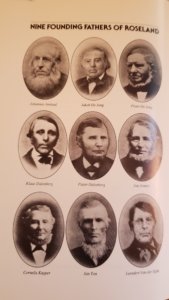Rivers of Thought
Life, Leadership, Business & Technology
 Let’s do coffee. I would be hard-pressed to count the number of cups of coffee I’ve had at local coffee shops. Two, three, four times a week for ten or eleven years. THAT is a lot of coffee. Let’s do coffee. It sounds like a tone-deaf imperative in this age of social distancing. However, despite the stay-at-home and social distancing mandates, it is a practice I have maintained, albeit virtually.
Let’s do coffee. I would be hard-pressed to count the number of cups of coffee I’ve had at local coffee shops. Two, three, four times a week for ten or eleven years. THAT is a lot of coffee. Let’s do coffee. It sounds like a tone-deaf imperative in this age of social distancing. However, despite the stay-at-home and social distancing mandates, it is a practice I have maintained, albeit virtually.
Let’s do coffee. It is a commitment I made eleven years ago. It’s my way of saying thank you and paying it forward to those who took time out of their busy schedules to have coffee with me. In 2009, I found myself in a position I had not been in up to that point in my career. I was in a job search. I was in a job search without having a job. I was struck by the number of people who stopped what they were doing to meet for coffee, talk, and help.
What is it about coffee?
Today, my coffee meetings fall into three broad categories: catching up with friends, sales professionals who want my take on the local market, and, yes, people in transition (and those considering a change). Whenever anyone in the latter category reaches out, my answer is “Let’s do coffee”.
In fact, “Let’s Do Coffee” was the working title for my new book Amplify Your Job Search – Strategies for Finding Your Dream Job. Until, well, you know, branding (hey, I am kind of the #AmplifyGuy, #RockandRollScarecrow, #RocktheSox guy). The book is a culmination of lessons learned, advice received, advice given, and experience. Sorry for what feels like a commercial interruption, that is not my intent…but, if you want to buy the book you can get it on…nevermind!
Over these years of having coffee, I have seen many professionals who were prepared for their search. They knew who they were and they knew what they wanted. I have seen others who, well, weren’t and didn’t. Other than working with the university’s career services department or with an outplacement firm, we don’t teach someone how to search for a job. (Hence, the need for the book and more shameless promotion of same).
I believe the difference between those who did and those who didn’t comes down to two essential and related practices: reflection and branding.
Reflection
Journaling has been a part of many successful leaders for centuries. The library is full of biographies and autobiographies of business leaders, government leaders, and thought leaders. The common thread, most kept some sort of record (uh, journal) of their thoughts, insights, and activities.
Keeping a journal is a powerful tool. Not only does it help you to keep track of details that would be lost to time, but it provides a way to learn from the past…your past. Part of the magic of keeping a journal is to re-read it, weeks, months, even years later. The magic? The lessons change! Why? The journal hasn’t changed…you have!
Keeping a journal is a great way to understand who you are and what you want and need from your career. I know I have written of this in prior posts…I just can’t emphasize the importance enough.
Branding
Personal branding is the other essential element, and yes, it is related to journaling. Branding is who you are and how others see you. I was first introduced to personal branding in the mid-2000s by a boss of mine. I have to admit, I thought it was a load of crap! (Sorry, Ron!). Like many lessons in life, we learn the value of something long after we have been introduced to it.
We all have personal brands. It’s our reputation. How do people see you? What are their first impressions? What are their lasting impressions? That is your personal brand. The question isn’t do you have one, but rather, is it an intentional one? Do you curate your brand?
A personal brand is made up of four components: your strengths, your values, your passions, and your purpose. Identifying those components takes deep reflection (hence the relationship with journaling). Have you done the work? Do you know your personal brand?
Coffee and Leadership
Reflection and Branding are not only essential to a job search. They are essential to leadership. If you don’t journal, I urge you to start today. It is easier than it sounds. If you don’t know your personal brand, begin to explore the key components. THAT is your call to action from reading this post. Start today!
Read more about reflection, branding, and coffee in my new book Amplify Your Job Search – Strategies for Finding Your Dream Job! Learn more and order your copy by clicking on the cover:

From “Down an Indian Trail in 1849” by Mary K. Rowlands
Last month, as you may recall, I invited you along on a journey: a journey of discovery into some of my family history. I’ve learned a lot in one month..but have a lot more to learn. I’ve exchanged LinkedIn messages with LeRone Branch, the Eagle Scout turned Tax Accountant, who helped develop the memorial to my great-great-grandparents Jan and Aagje (Vander Sijde) Ton. I’ve emailed several times with Paul Ton of Michigan, descended from Jan’s brother, Harmen, and I’ve read two and a half books that mention Jan and others in the Ton family.
Correcting the Record
Part of what I have learned is that I had some of my facts wrong in my post last month. In that post, I mentioned Jan and Aagje immigrated to the U.S from Holland (Netherlands) in the 1840s with eight of their nine children. That is not correct. As is often the case with old records, it is easy to get confused when children carry the same name as one of their parents. Many times records do not include suffixes such as Jr. or Sr. or even II and III.
My great-great-grandfather, Jan, was 23 years old and single when he immigrated to the U.S. aboard the ship, “Massachusetts of Boston”, sailing from Le Havre, France in April of 1849. Jan was the son of Jan and Peterje (Stam) Ton, my great-great-great-grandparents. THEY had nine children. It was eight of their nine children who, over time, immigrated to the U.S. So, you can see how confusing that can get! The “Massachusetts of Boston” carried two Tons across the Atlantic, Jan and his married sister, Jannetje (Ton) Eenigenburg. Many of the families settled south of Chicago near Lake Calumet. Jan and eight other immigrants are considered the founding fathers of what is now Roseland, Illinois.
It appears from the records I can find there might have been some shenanigans going on onboard the ship. Jan and Aagje’s first son, Jan Jr. was born in February of 1850. Jan and Aagje would marry in 1853 and raise 14 children to adulthood.
The Underground Railroad
I am certain to have many more stories to tell as I learn more, but, I do want to relate a story that directly connects Jan and Aagje to the Under Ground Rail Road. The story is found in the 1923 book “The Wonder of the Dunes” by George A. Brennan. You see, what is now Indiana Dunes National Park was traveled by many freedom seekers on their way from Chicago to Detroit and on into Canada. The Hollanders settlement near Lake Calumet was a leading station along that portion of the underground railroad.
This particular story was retold many times over the years by Cornelius Kuyper, a dear friend of my great-great-grandfather’s and the town constable. Mr. Brennan records the story in his book. In his capacity as the constable, Kuyper was often called upon to assist in capturing run-away freedom seekers. He would attack each request with such zeal and effort, he would receive praise from slave owners and sheriffs alike…though…he never succeeded in capturing any freedom seekers.
A Story to Tell
As Kuyper tells the story, one day he was visited by a slave owner from Kentucky, a sheriff deputy from Chicago, and a posse. They were pursuing three freedom seekers, each with a $3,000 price on their heads. As was his norm, Kuyper searched high and low for the runaways, even taking the posse as far as the Illinois-Indiana state line. Once again, he came up empty-handed.
When they returned to Kuyper’s home, his wife Maartje prepared and served them a meal before they headed back to Chicago. After they were safely on their way, Kuyper headed into his cellar, opened a trap door, and summoned one of the freedom seekers who he had hidden away. He then went to the barn and moved part of an immense stack of hay, the other two freedom seekers emerged. He fed them, had them climb in his wagon covered them with cobs of corn, and took them to the home of Jan Ton. Jan hitched up his wagon, transferred the precious cargo, and headed out toward Indiana. Near the town of Hohman Bridge (today’s Hammond, Indiana), the cargo was transferred to another wagon. The freedom seekers were well on their way to Canada.
One can only imagine the countless times these men and women provided this service to others on their journey!
As I learn more, we will continue on this journey together. Until next time!
 Should I share my story? It’s a question I get asked often. It’s a question I used to ask myself. I was asked the question again a couple of weeks ago. I was on a Zoom coffee call when the question came, almost out of leftfield. Should I share my story? This time the question caught me a bit off guard. I’m afraid my momentary confusion caused me to hesitate, it might have even caused me to stammer a bit. I’m afraid it might have caused my answer to seem less confident, less emphatic than I intended.
Should I share my story? It’s a question I get asked often. It’s a question I used to ask myself. I was asked the question again a couple of weeks ago. I was on a Zoom coffee call when the question came, almost out of leftfield. Should I share my story? This time the question caught me a bit off guard. I’m afraid my momentary confusion caused me to hesitate, it might have even caused me to stammer a bit. I’m afraid it might have caused my answer to seem less confident, less emphatic than I intended.
I can assure you that was not the case. I just was not expecting the conversation to turn in the direction it did. You see, this was the first time I had met this person. Typically, I get asked that question by people whose story I already know (at least somewhat). This being the first time we had met, it threw me off…at least momentarily. Let me answer now, with all the confidence and as emphatically as possible…”YES, YOU SHOULD SHARE YOUR STORY”. Your story is who you are, you should own your story! This was one of the most impactful recommendations I have ever received, and I think it can have as great an impact on you and your career as it did for me.
This person’s story was of a battle with alcoholism. They are recovering, but they are an alcoholic. You may be asking why on earth would someone share that with someone they had just met. Well, because it is a story of strength and courage. It is a story of vulnerability. Something in our conversation must have let them know it was a “safe zone” to tell the story and then ask the question. Little did they know the impact they would have on me because they shared. I was honored they felt they could share. They had no way of knowing the number of people in my life who battle the same affliction.
Why should you tell your story? Because sharing our stories creates an immediate connection. There is something about being vulnerable. There is something in creating trust between people. It’s funny how in sharing our stories and being vulnerable what we are really sharing is our strength. The connection created is real. The connection created is deep.
When I asked permission to share this story, they responded with “I can’t tell you how much it meant to me to feel vulnerable and safe enough to pose the question and be affirmed by someone else in a leadership role. My strength comes from my vulnerability and ability to connect with others on a deeper level. My alcoholism no longer defines me because I am no longer ashamed.” Powerful. The connection works both ways.
It was not more than a week later when I was confronted with the power of sharing one’s story again. This time it was with at a meeting of the Indy CIO Network. We had a guest facilitator, Paul Ashley of FirstPerson Advisors, we were to discuss mental wellbeing during a pandemic. Before the meeting, Paul shared his story with the group. Paul’s story is one of battling depression. His vulnerability connected with the group which led to a great discussion. Powerful. Several members shared their own stories. Based on the follow-up conversations, I know it has led to deeper connections between our members.
My point isn’t that your story has to include battling alcoholism, or depression, or cancer. It doesn’t have to include anything that dramatic. My point is your story is important. It is what makes you who are. Sharing it can create connection. Sharing it can show you care about other’s stories. Sharing it can help you to lead.
Post a comment, send an email, give me a call! I want to hear your stories!

Insights is the weekly, thought-provoking newsletter from Jeffrey S. Ton.
Every Tuesday – Delivered to your inbox.
A different focus each week:
Leadership Thought – A lesson-learned, an insight shared
Leadership Q&A – A response to a reader’s or a connection’s question
Leadership Spotlight – A highlight of a person or company helping others to grow their leadership
Rivers of Thought – A more personal thought, observation or musing




